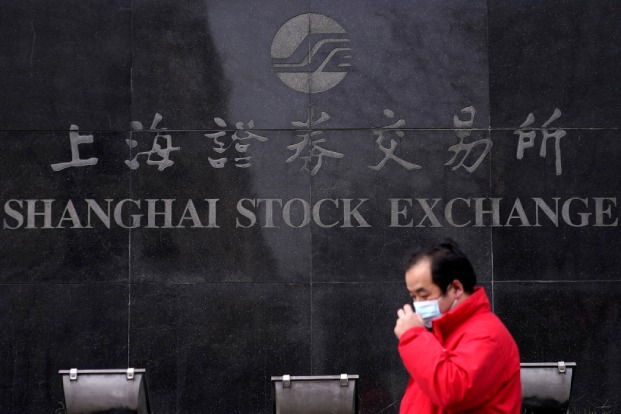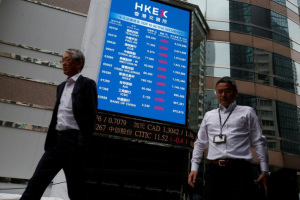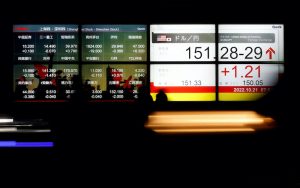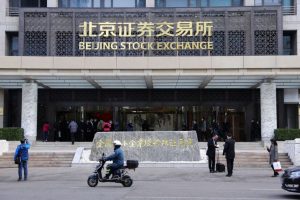China’s stock markets boasted a combined market capitalisation of $13.37 trillion in 2021 and the capital raised over recent decades has been a critical tool in driving economic growth in the world’s second-biggest economy.
The Shanghai and Shenzhen stock exchanges have now been joined by a new Beijing bourse, creating a fresh three-way rivalry and providing a boost for the cash-starved small- and medium-size enterprises that heavily contribute to China’s progress.
Traditionally, China’s trading floors have been closed off to overseas investors but as its global ambitions have advanced those restrictions have loosened, though only just over 5% of shares are currently owned by international investors.
Hundreds of Chinese companies are listed on offshore stock exchanges but now, with regulatory crackdowns at home and trade pressures abroad, attempts are being made to lure some of China’s most coveted overseas-listed companies back to the country.
Here, in this special Asia Financial guide, we take a look at the three stock exchanges on the Chinese mainland – and look at how foreign investors can participate in the world’s fastest-growing capital market.
Shanghai Stock Exchange
Market Capitalisation: $7.73 trillion (2022) Wind
Number of Listed Companies: 1,561
The Shanghai Stock Exchange (SSE) is the world’s third-largest stock market by market capitalisation and Asia’s biggest. It is run as a non-profit operation by the China Securities Regulatory Council (CSRC).
The SSE boasts two trading boards, its Main Board – or Shanghai Composite index (SHCOMP) – and the Science and Technology Innovation Board, better known as the STAR Market.
There are also SSE 180, SSE 50 and SSE Mega-Cap Indexes for the top 180, 50 and 20 companies respectively, and the CSI 300 Index, which includes shares traded at the Shanghai Stock Exchange and the Shenzhen Stock Exchange.
The Main Board is home to mainly large, well-established Chinese companies, explains Asia business guide China Briefing, and lists both A-shares and B-shares – both have the same equity value but A-shares will carry more voting rights.
A-shares are equities in companies incorporated and listed in China, denominated in Chinese yuan, and only available to non-qualified foreign investors in the China stock market through special stock buying programmes.
B-shares are available for companies incorporated and listed in China and are denominated in both US dollars and HK dollars – if traded in Shenzhen – and are directly accessible to foreign investors.
As of May 2021, the manufacturing sector represented the largest share of companies at the Shanghai Stock Exchange, accounting for 1,180 companies at the bourse.
Across the exchange, as of January 2022, the sectors most represented are banking (18.5%), capital goods (10.3%), manufacturing (10.1%), food and drink (9.6%) and energy (8.2%)
The STAR Market, or Shanghai Stock Exchange Science and Technology Innovation Board, leans more toward smaller tech companies, especially those in 5G technology, semiconductors and new energy, and currently has 340 listed securities and enables startups to attract investment they might not get abroad.
Largest firms (market caps in US dollars, January 2022)
Kweichow Moutai > $382 billion
Industrial and Commercial Bank of China > $253 billion
China Merchants Bank > $200 billion
Agricultural Bank of China > $161 billion
Ping An > $150 billion
PetroChina > $144 billion
Bank of China > $136 billion
China Life > $110 billion
Great Wall Motor Company > $79 billion
China International Travel Service Corp > $72 billion
Source: Wind (Jan 2022)
Shenzhen Stock Exchange
Market Capitalisation: $5.59 trillion (2022) Wind
Number of Listed Companies: 2,268
The Shenzhen Stock Exchange (SZHE) is the sixth-largest stock exchange in the world, and the third-largest in Asia.
The SZSE has three main trading boards, the Main Board, the SME Board and the Growth Enterprise Market (GEM) board, which is also called the ChiNext.
Manufacturing companies make up the majority of the companies listed on the Main Board and many of those are state-owned or partly state-owned.
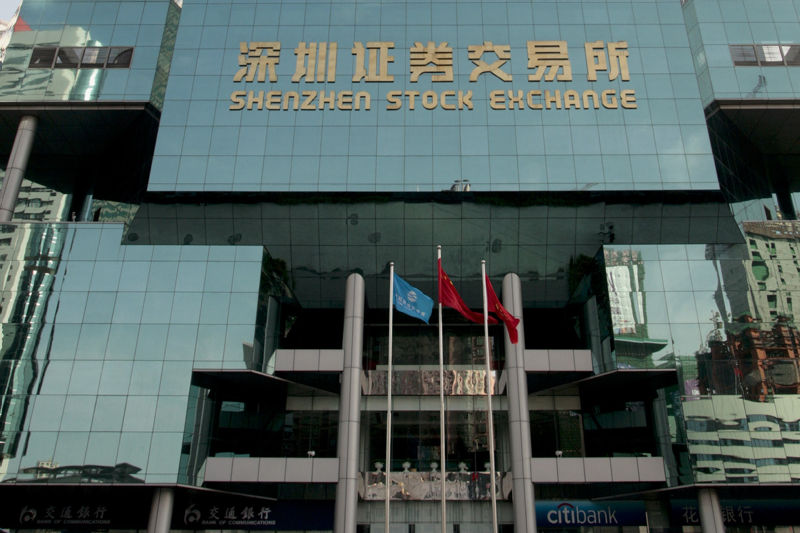
The SME Board was set up in 2004 for stable companies with well-defined businesses and many of the enterprises on this board are in manufacturing, too. As a result, the SME Board is often seen as a China stock market barometer of the sector.
And similarly to Shanghai’s STAR Market, the ChiNext focuses on small startups, according to China Briefing, especially from high-tech and new industries.
Across the exchange, the sectors most represented are manufacturing (18.7%), food and drink (11.5%), capital goods (11.4%), tech and hardware (10.5%) and automobiles (6.7%).
The SZSE’s products include A-shares, B-shares, indices, mutual funds, fixed income products, and diversified derivative financial products. Many of the companies listed on the exchange are units of companies in which the Chinese government has significant interests.
Largest firms (market cap in US dollars, January 2022)
Contemporary Amperex Technology > $197 billion
Wuliangye Yibin > $132 billion
BYD Company > $92 billion
Midea Group > $85 billion
Hangzhou Hikvision Digital Technology > $73 billion
Shenzhen Mindray Bio-Medical Electronics > $62 billion
Yihai Kerry Arawana Holdings Co Ltd > $56 billion
East Money Information > $55 billion
Luzhou Laojiao > $54 billion
S.F. Holding > $53 billion
Source: Wind (Jan 2022)
Beijing Stock Exchange
Market Capitalisation: $32 billion (January 2022) Wind
Number of Listed Companies: 81
Chinese President Xi Jinping announced the creation of a new stock exchange in Beijing for small and medium-sized enterprises (SMEs) in September, 2021.
The board focuses on innovation-oriented companies providing a boost for cash-starved small and medium-sized enterprises.
With a focus on “zhuan jing te xin” – specialised, excellent, differentiated and innovative – companies, the Beijing exchange boasted 81 companies at launch, including Beijing Henghe Information Technology, Keda Automation Control and Anhui Jingsai Technology.
In February 2022, a total of 86 companies were listed on the exchange and two new enterprises went public in that month.
The Beijing exchange is easier to access for retail investors compared with its predecessor, the NEEQ Select board. It requires a minimum of 500,000 yuan ($78,100) of assets in a retail investor’s brokerage account while the NEEQ Select board asked for twice that amount.
The Beijing exchange is 100% owned and operated by the National Equities Exchange and Quotations Co Ltd (NEEQ). It does not set a minimum dividend percentage for listed companies, and it also inherited a market-making scheme from its predecessor, the NEEQ Select tier.
The establishment of the bourse underlined policymakers’ efforts to support small businesses. The private sector contributes more than 60% of gross domestic product, more than 70% of technological innovation and more than 80% of urban employment, according to Vice Premier Liu He, who is President Xi Jinping’s top economic adviser.
Across the exchange, the sectors most represented are manufacturing (43.5%), capital goods (21%), tech and hardware (9.5%), pharmaceuticals and biotech (7.7%) and software (5.7%).
The launch of the Beijing-based exchange also came as the door is closing for Chinese tech stocks overseas, due to stricter scrutiny on these firms in both China and the United States.
Beijing has been trying to persuade its firms to list in China stock markets and be less dependent on foreign money and technology, a push that intensified during the trade war with Donald Trump’s US administration.
The Chinese government is also keen to prevent sensitive data held by its tech companies falling into the hands of foreign governments – manifested in its move in July 2021 to suspend Didi days after the ride-hailing giant’s US IPO, citing data collection violations.
Largest firms (market cap in US dollars, January 2022)
BTR > $16.5 billion
Nutrichem > $12 billion
Tongli Active > $5 billion
Liancheng Digital Control > $4 billion
Changhong Energy > $4 billion
Hanbo Hi Tech > $3.5 billion
Jilin Carbon Valley > $2 billion
A Spherical Cable > $2 billion
Morning Optical Cable > $1.5 billion
Dezhong Automobile > $1 billion
Source: Wind (Jan 2022)
Comparing the Three Bourses on China’s Stock Market
“The Beijing stock exchange has equal footing with Shanghai and Shenzhen bourses,” said Rock Jin, economist and CEO of investment adviser PopEton “If it prospers, the three will share the market in tripartite confrontation.”
China launched the new exchange as part of efforts to channel more household savings into the stock market to fund innovation and economic recovery, while reducing the economy’s reliance on bank lending. It also came as US-listed Chinese companies face the risk of delisting amid Sino-US tensions.
Compared with China’s two other Nasdaq-style boards – the STAR Market in Shanghai, which has a tech focus, and ChiNext in Shenzhen, which serves more sectors – the Beijing exchange is intended for startups that are even smaller and at an earlier stage of growth.
The Shanghai stock exchange, by comparison, is home to the country’s large, state-owned companies and most of its investors are pension funds and banks.
The Shenzhen stock exchange is the smaller exchange and features the shares of more entrepreneurial companies and most of its investors are individuals. A lot of China’s tech companies are listed there, making this exchange similar to the NASDAQ.
Foreign Investment in Chinese Stocks
For foreign traders interested in investing in China’s stock market, the main two schemes they have been using are the Qualified Foreign Institutional Investor (QFII) and Stock Connect programmes.
In recent years, the Stock Connect programme has come to replace the older QFII as the main access route for onshore Chinese equities.
The QFII – and the RMB Qualified Foreign Institutional Investor (RQFII) scheme – enabled qualified foreign institutional investors to gain direct access to China capital markets, explains a BNP Paribas note. They could trade A-shares of Chinese stocks, bonds and securities investment funds, denominated in China’s yuan.
In November 2020, a new QFI regime – the collective name for QFII and RQFII – aimed to ease that access into China’s capital markets.
The most significant change was the merger of the QFII and RQFII schemes into one scheme, allowing for a one-time application with relaxed entry criteria and simplified application documents.
The approval time was also reduced from 20 days to 10 working days once the application documentation fulfilled CSRC requirements.
The investment scope had been significantly extended too. Now foreign investors could also trade NEEQ securities and asset-backed securities on the exchange markets and financial futures, commodity futures, and options and also engage in margin trading and securities lending.
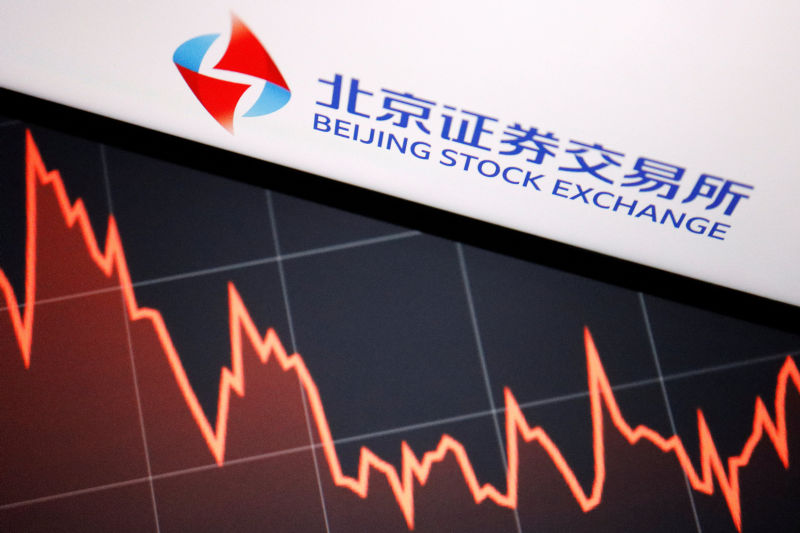
It’s also worth noting, said BNP Paribas, that quotas were removed and the cash repatriation process simplified under the new QFI scheme. This meant foreign investors could now remit cash freely to China as per their investment plan.
Despite being the second-largest equity market in the world, Chinese onshore equities were not included in broad indices because of their limited accessibility and the restrictions accompanying the QFII programme, explained a Nipun Capital note.
In a step towards changing this, the Stock Connect scheme was launched in 2014 allowing foreign investors to invest in Shanghai-listed equities via Hong Kong.
Stock Connect offered ease of registration and daily liquidity and was expanded in 2016 to include Shenzhen-listed stocks, including stocks listed on the ChiNext board.
As the Connect programme grew in depth and breadth, replacing QFII as the main access point for China, when MSCI decided to include Chinese equities in its indices in 2018 most investors used the Connect route to build positions in the Chinese stock market.
But there has been lobbying by onshore brokerage firms, says Nipun, to revive the QFI by loosening some of its restrictions with Stock Connect dominated by global brokers serving foreign clients through Hong Kong.
Nipun sees the two schemes converging over time, though that evolution will be driven by the intent of the Chinese Government, their flexibility and desired pace of change.
The impact of Common Prosperity and Crackdowns on China’s Stock Markets
The regulatory crackdowns triggered by Chinese President Xi Jinping’s drive for ‘common prosperity’ have turned what was always a risky China stock market into a treacherous one.
The assault on everything from big tech to private tutoring firms and home prices have triggered alarm over what Xi’s ‘profound revolution’ means for investors.
To help navigate these turbulent times, Societe Generale analysts led by Yao Wei, Paris-based head of Asia Pacific research, came up with a guide that includes a “Common Prosperity Basket” of 30 stocks deemed the most likely to thrive in the years ahead.
Assets at high risk and with weak outlooks include private tutoring firms, real estate, oil and coal. “They are simply sectors of the past,” say the SocGen analysts. Internet stocks are excluded, too, because “the regulatory clampdown is not likely to end in the short term, both with regard to platform content, data security and governance considerations,” they say.
Media players are at risk because of strict data security measures and online retail companies are prey to antitrust and data swoops. Liquor and tobacco are to be shunned because policy now stresses the improvement of public health, while real estate is best avoided at a time when the country is aiming to reduce rising housing costs.
Offshore indexes and those with a large majority of offshore names are more exposed to policy risk, with MSCI China and the Hang Seng Tech the indexes carrying the highest risk, SocGen says. ”The large internet firms are all listed overseas, while hardware technology and biotechnology stocks tend to be listed onshore,” it says.
China Stock Market Top Picks
In SocGen’s basket of 30 China stock market equities positioned to thrive amid ‘Common Prosperity,’ smart manufacturing companies account for two-thirds of the picks because those industries are likely to be favoured by Xi’s aim of “fostering technological independence and ecological transition.” The basket also includes selected financial and consumer companies.
SocGen identifies five sectors that have both policy winds behind them and strong growth outlooks:
1 – New energy vehicles, electronics, home appliances and other electronics should gain policy support given the goal of upgrading manufacturing and transitioning to green energy.
2 – With policymakers aiming for carbon neutrality by 2060, renewables and storage are well placed.
3 – New materials related to batteries, chips, aerospace, and electronics will gain support as policymakers aim to overcome supply bottlenecks.
4 – New infrastructure in areas such as 5G, data centres, and EV chargers fits well with China’s ambition to become a manufacturing powerhouse.
5 – Semiconductors and hardware technology will help the nation reduce its dependence on imports and strengthen local manufacturing skills and capacity.
The STAR 50 and ChiNext indexes are considered those with the lowest risk of regulatory crackdowns.
The bottom line for China’s stock markets? If successful in raising productivity and improving the quality of growth, ‘common prosperity’ could yet support long-term equity investment, the SocGen analysts say.
- By Sean O’Meara with additional reporting by Iris Hong
Read more:
How To Invest Amid China’s Era of ‘Common Prosperity:’ Societe Generale
China’s New Beijing Exchange Sets Up Potential Bourse War




